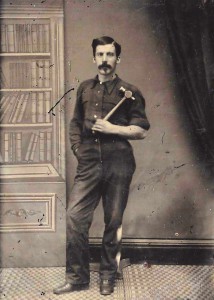Among my husband’s family papers is a letter, dated 25 October 1873, from John Dill to his mother, Susan (Berry) (Dill) Gibbons. John had left the family home in Springfield, Illinois, earlier that year to work on the railroad in Texas, and he was alarmed about the impending marriage of his younger sister, Ida Dill:
This thing of Ida getting acquainted Courting and marrying all in about a month I do not believe in and more than it is a dam humbug. . . . How do you know what that fellow is or has bin you cant find out so much in such a little time.
Within two weeks, John was dead, likely of yellow fever. During that time, Ida’s courtship weighed heavily on his mind. In a letter to Ida dated 8 November, John’s friend wrote to tell her the particulars of John’s death and then added “one more woard”:
this he said on his daying bead that if the sister knew how sick he was she would think of every thing elcs but marieing.
John’s sister was Ida Alice Dill, my husband’s great-grandmother. The dreaded groom-to-be was Frank Stratton. You can tell by my surname that the marriage took place: on 18 December 1873.
Despite John’s misgivings, Frank and Ida had a long marriage, producing two children. And in terms of knowing where Frank “has bin,” we were lucky to have a detailed backstory that Frank gave his son, my husband’s grandfather. He had grown up on a little plantation outside Columbia, South Carolina, son of Franklin and Marian (Marion) Stratton, who was the granddaughter of Revolutionary War General Francis Marion. Franklin and his other son, George, fought for the Confederates and were killed at Gettysburg. Frank himself fought with the 2nd South Carolina and 11th Mississippi.
Unfortunately, just about every detail of that backstory is unprovable – and one detail is absolutely false: General Marion had no children and therefore no grandchildren.
Before Frank shows up in Illinois and marries Ida in 1873, we can find absolutely no trace of him. No permutation of the name Stratton, no search of records North or South, has revealed a clue. Was he a nineteenth-century Don Draper, taking another soldier’s identity? Did he change his name, or have we just not yet hit on the right spelling variation? Are the Southern stories true, and all the records destroyed or disappeared? Why, it’s a “dam humbug”!
Share this:
About Penny Stratton
A veteran of the book publishing industry, Penny Stratton retired as NEHGS Publishing Director in June 2016; she continues to consult with the Society on publications projects. Among the more than 65 titles she managed at NEHGS are The Great Migration Directory, Elements of Genealogical Analysis, Genealogist’s Handbook for New England Research, and the award-winning Descendants of Judge John Lowell of Newburyport, Massachusetts. She has written for American Ancestors magazine and is a regular poster on Vita Brevis. With Henry B. Hoff, Penny is coauthor of Guide to Genealogical Writing: How to Write and Publish Your Family History; she is also the author of several Portable Genealogists on writing and publishing topics.View all posts by Penny Stratton →
